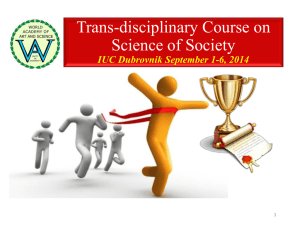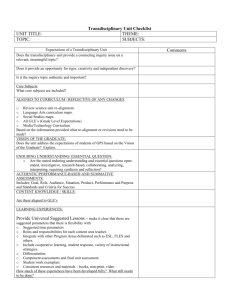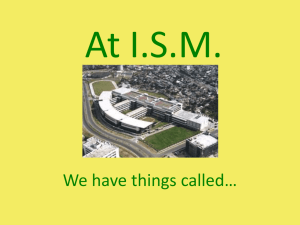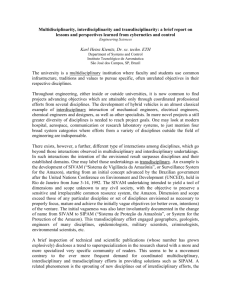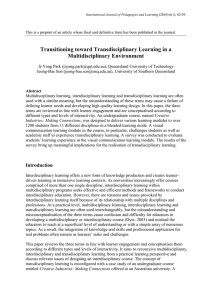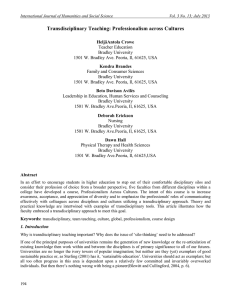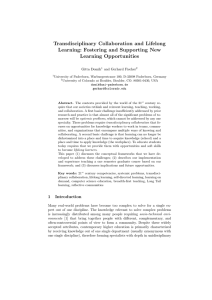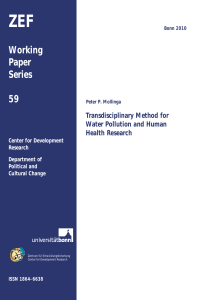by Joseph Rufo (facilitator), Russell D. Briggs (division director), Margaret Bryant... Douglas Daley (faculty), Jacqueline Frair (faculty), Robert Malmsheimer (faculty), Paul...
advertisement
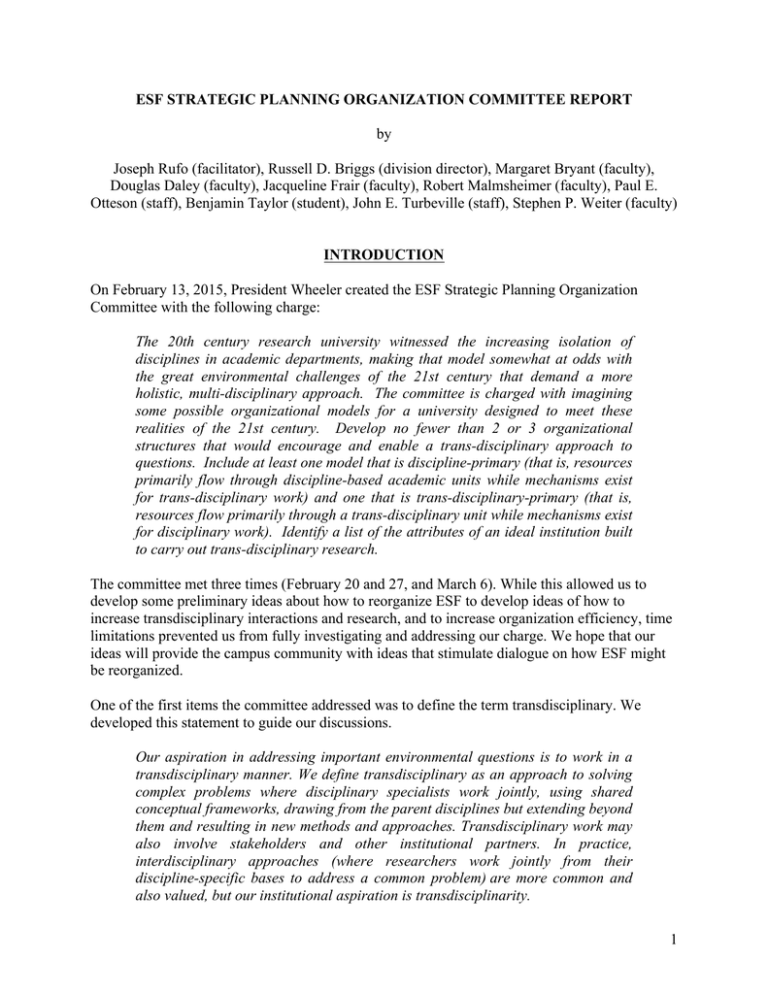
ESF STRATEGIC PLANNING ORGANIZATION COMMITTEE REPORT by Joseph Rufo (facilitator), Russell D. Briggs (division director), Margaret Bryant (faculty), Douglas Daley (faculty), Jacqueline Frair (faculty), Robert Malmsheimer (faculty), Paul E. Otteson (staff), Benjamin Taylor (student), John E. Turbeville (staff), Stephen P. Weiter (faculty) INTRODUCTION On February 13, 2015, President Wheeler created the ESF Strategic Planning Organization Committee with the following charge: The 20th century research university witnessed the increasing isolation of disciplines in academic departments, making that model somewhat at odds with the great environmental challenges of the 21st century that demand a more holistic, multi-disciplinary approach. The committee is charged with imagining some possible organizational models for a university designed to meet these realities of the 21st century. Develop no fewer than 2 or 3 organizational structures that would encourage and enable a trans-disciplinary approach to questions. Include at least one model that is discipline-primary (that is, resources primarily flow through discipline-based academic units while mechanisms exist for trans-disciplinary work) and one that is trans-disciplinary-primary (that is, resources flow primarily through a trans-disciplinary unit while mechanisms exist for disciplinary work). Identify a list of the attributes of an ideal institution built to carry out trans-disciplinary research. The committee met three times (February 20 and 27, and March 6). While this allowed us to develop some preliminary ideas about how to reorganize ESF to develop ideas of how to increase transdisciplinary interactions and research, and to increase organization efficiency, time limitations prevented us from fully investigating and addressing our charge. We hope that our ideas will provide the campus community with ideas that stimulate dialogue on how ESF might be reorganized. One of the first items the committee addressed was to define the term transdisciplinary. We developed this statement to guide our discussions. Our aspiration in addressing important environmental questions is to work in a transdisciplinary manner. We define transdisciplinary as an approach to solving complex problems where disciplinary specialists work jointly, using shared conceptual frameworks, drawing from the parent disciplines but extending beyond them and resulting in new methods and approaches. Transdisciplinary work may also involve stakeholders and other institutional partners. In practice, interdisciplinary approaches (where researchers work jointly from their discipline-specific bases to address a common problem) are more common and also valued, but our institutional aspiration is transdisciplinarity. 1 PRINCIPLES OF ORGANIZATION/REORGANIZATION To guide its analysis of why we must reorganize, the committee developed the following principles for organization and reorganization: 1. Organization/reorganization must serve the goal of advancing ESF’s positive impact on the world. 2. The strategic plan should establish ESF as a unique, forward-thinking institution that provides relevant knowledge, experiences, networking, and skill development opportunities for its students. 3. Higher education is facing uncertainties and challenges. The strategic plan should address: a. Declining support from state government b. A changing marketplace with competition from online degree programs, with changing demographics, and other types of fluidity. 4. An organizational model should be flexible and adaptable to changing circumstances. It should facilitate experimentation with research and teaching approaches. a. Critical: accommodate change in what the “right questions” are at any moment in time. 5. An organizational model should facilitate transdisciplinary research and education to address questions of importance to society (currently identified as “four questions”). 6. Greater efficiencies across all levels of the institution are sought. Any new model must be explicit about current inefficiencies and also about how the new model reduces specific inefficiencies. a. ESF should actively pursue efficiencies in instruction through digital technologies. b. Efficiencies in masters program administration (thesis/no-thesis) and professional studies programs should be sought. c. Efficiencies in provision of research equipment and support should be sought. 7. Disciplinary depth should be maintained, while networks for transdisciplinary research are actively built and supported. 8. Administrative structures should be efficient and responsive to the evolving needs of higher education. 2 POSSIBLE MODELS The Thinking Behind the “Keep The Status Quo” Scenario Resistance to change • Uncertainty in outcome. There is uncertainty whether any reorganization will provide the desired payoffs in the long-run, but certainty that any reorganization would create turmoil and at least temporary inefficiencies. Increase efficiency with minimal pain • Eliminate unproductive programs. Assess and “sunset” centers / institutes, academic programs, and courses that are considered inefficient in terms of resources and impact. Foster inter-disciplinary networking and research • Invest in existing programs that foster interdisciplinary collaboration. Support existing centers / institutes that foster inter-disciplinarity, highlight/market existing interdisciplinary degree programs, and continue coordinating interdisciplinary graduate program within the Division of Environmental Science. Key to the diagram • All undergraduate majors and graduate areas of study are indicated, undergrad majors are set off by italics. Inter-disciplinary majors and areas of study are indicated in bold (some within existing departments, most within GPES) • Shaded areas indicate the degree to which departments are vested in the major questions. 3 The Thinking Behind the “Play To The Questions” Scenario Reorganize with interdisciplinary collaboration in mind • Break down the columns. Current departments and majors create too much separation. Here, the four major questions are envisioned as intersections between three overall disciplines – life sciences, social sciences, and design – reducing the number of divisions. • Disciplines fall along gradients. Academic program areas can be organized from most interdisciplinary (general) at the center to becoming more disciplined (specific) as you move outward. Specialized graduate programs might fall as tangents to the large circles. • Intersections drive collaborations. Areas of intersection across disciplines highlight collaborative research opportunities. • Students create their own path. An incoming freshman could be thought of as a line, starting in the middle and forging their own path outward and with several points of intersection among the major questions along their path. • Rethink academic programs. Here, existing majors and graduate areas of study have been mapped onto the questions, but these likely will need to be radically re-envisioned. Note: This model was developed by an inter-disciplinary group of undergraduate students. 4 The Thinking Behind The “Streamline For Strength” Scenario Increase organizational efficiency • Pool our human resources into fewer units. Use general coursework and areas of research to define new divisions (clusters of similar areas of study) within academies (clusters of complimentary areas of study). Natural areas for interdisciplinary collaborations are indicated by overlap among the major questions. • Re-envision academic programs. Under the reorganized divisions will come opportunities to design academic majors that play to new strengths and to “sunset” centers / institutes, academic programs, and courses that are inefficient in terms of resources and impact. Foster inter-disciplinary networking and research • • Create shared resource labs. Pool technical resources among researchers to make them more accessible to the larger community (fostering interdisciplinary collaborations) while also increasing sustainability (multiple programs pay fees to maintain equipment and support technical staff). Establish a graduate school. A centralized graduate school encourages interdisciplinary collaborations through degree programs and academic committees as well as directing resources to encourage specific areas of enquiry. Could provide greater support for producing large, inter-disciplinary grants proposals. Ensures concerted attention on our professional degree programs. 5 The Thinking Behind the “Streamline And Play To The Questions” Scenario Increase organizational efficiency • Pool faculty and staff into fewer units. Identify three or four cross-disciplinary faculties. Faculty may either be selected or self-select into these faculties. Foster inter-disciplinary networking and research • Transcend disciplines. All faculties have some role in addressing each of the major questions. A scholar might have a home in a particular faculty, but teaching, advising, and research would transcend borders. • Create new supporting units. The faculties are supported by five operational/support units within Academic Affairs. For example, integrate Computing and Network Services and Information/Education Technology into one unit for efficient coordination. 6 MECHANISMS OF CHANGE Concentrated organizational changes, new collaborative teams, and targeted actions that could be put into play quickly to effect urgent changes and enable the rapid rise of new operational structures and processes • Teams – Assemble teams to lead targeted, opportunistic, high-value “change actions” in response to concrete needs and opportunities. • Targeted Investments – Invest in more technological infrastructure that would enable pedagogical methods which would replace “the worst lectures.” More bandwidth and capability to teach, for example, Philosophy of Science to undergrads in small mixed online and off-line group seminars rather than a 350 seat lecture hall. Build an instructional support and design center to facilitate new approaches and build transdisciplinary interaction. • Revamped GenEd – A revitalized General Education curriculum that results in what would be a hallmark of an ESF education: graduates who are project-experienced, problem/solution-oriented, and critical thinking and cross-disciplinary-minded. • Project Opportunities – An option for every undergraduate to work on a transdisciplinary, real world project in the course of their studies here. Team-taught, studio-style courses could be run each year, with a focus on the “four questions” themes. (If 10 faculty self-selected to be involved in a course like this, and each had 10 students, then 100 students per year could have this experience. In terms of transdisciplinary network building, teaching such a class with a mix of faculty would facilitate the “laying bare” of different epistemologies and methodological approaches that is critical to creating conditions for transdisciplinary problem solving.) • Localized restructuring for targeted purposes – For example: o Information – To advance and integrate all things digital, merge Libraries, Information Systems (Administrative, Student, Public, Research, Instructional and Vended Solutions), Web Development (online information architecture), Online Education and Digital Media Creation. • Campaigns – Concerted marketing, communicaitons and/or fundraising efforts to meet goals such as higher out of state student percentage, establishment of endowed chairs, visibility of new trans-disciplinary center, etc. • Personnel Moves – Administrative, professional or academic hires or shifts to enable pursuits that are not currently possible, such as coherent development of online and hybrid education, completing a disciplinary faculty ‘set’ for a trans-disciplinary group, etc. • External Engagements – Public-private partnerships, intercollegiate collaborations, etc., to meet independently unattainable goals, such as certain kinds of multi-faceted research area relevance, consortium-level visibility, facilities access, sponsorships and other types of funding, etc. 7
